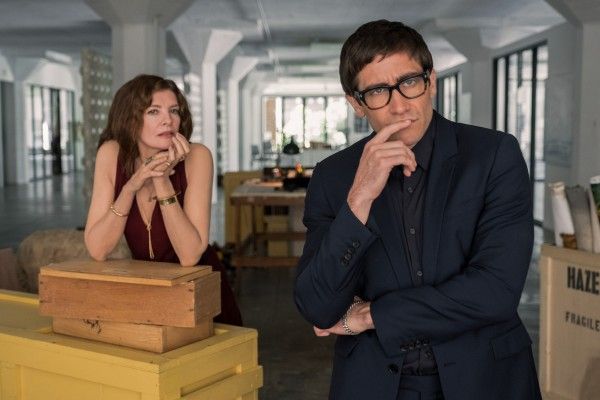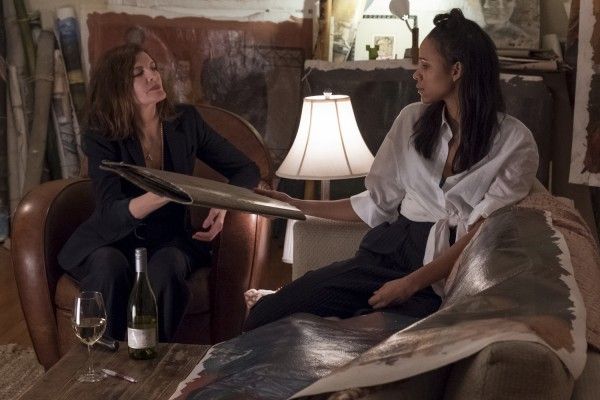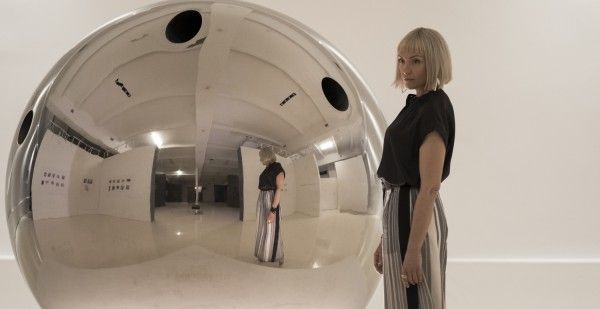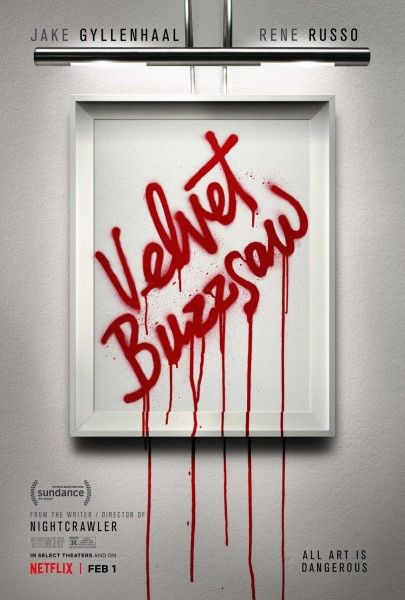Spoilers for Velvet Buzzsaw follow below. If you haven’t seen the movie yet, read at your own risk.
So you just finished Velvet Buzzsaw, which means you may have some questions. The Netflix original film hails from writer/director Dan Gilroy, who famously broke out with his 2014 thriller Nightcrawler, which also boasted two top-notch performances from Jake Gyllenhaal and Rene Russo. The trio reunited for Velvet Buzzsaw, which is, obviously, a very different kind of movie.
Before we get specifically to the ending, let’s break down what Velvet Buzzsaw is really about. Matt did a great job of dissecting its themes in his review, but this is a darkly comedic slasher movie in which, instead of camp counselors, it’s art dealers, and instead of a guy in a hockey mask, it’s art.
Everything you need to know about the film’s themes are set up in the stunning opening shot, in which a gallery showing introduces us to the film’s characters. Gyllenhaal plays Morf Vandewalt, a respected art critic who has the power to sway the price of art; Russo is Rhodora Haze, a former punk rock musician who now works as a gallery owner, buying and selling art; Zawe Ashton plays Josephina, Rhodora’s ambitious assistant who will climb the success ladder at any cost; and Toni Collette is Gretchen, a museum curator who is looking to jump ship to make more money.
What’s clear through the conversations amongst these individuals in the opening scene is that they don’t actually care about or appreciate the art—they’re concerned with its value and making money off of it. When Vandewalt comments on a piece by Piers (John Malkovich), saying that the artist was better when he was drinking, Rhodora notes that this piece actually was created before Piers got sober. Vandewalt breezes past the embarrassing error by simply saying, “Exactly.”
These people do not care about art. Or at the very least care more about the commercialization of art than the art itself. And that is why, according to Velvet Buzzsaw’s rules, they must be brutally murdered.
The crux of Velvet Buzzsaw revolves around the discovery and sale of alluring, ghoulish artwork by an unknown, mysterious artist named Ventril Dease. Josephina discovers troves of Dease’s artwork after he dies, and she ignores his wishes for it all to be destroyed, deciding instead to sell it. So she ropes Rhodora into the scheme, who not only sells the art but also attempts to hide away a portion of it for “a rainy day.” The first gruesome murder is of Bryson (Billy Magnussen), an aspiring artist who works as an installation man for Rhodora’s gallery, and who—upon discovering he’s been asked to stash away some of Dease’s art—tries to steal some for himself. For this he is burned alive and then consumed into a painting by literal grease monkeys.
As Dease’s art gains traction and notoriety, Vandewalt begins to investigate the background of Dease. The artist’s mother and sister were killed in a mysterious house fire when he was a child, he fought in the war, came back, brutally murdered his father, spent time in an insane asylum, etc. Honestly, Dease’s backstory matters as much as Freddy or Jason’s backstory. Velvet Buzzsaw is a slasher movie, after all. There’s some slight mythology to the Dease of it all, but the manner of the killings isn’t meant to be unraveled or unpacked like some mystery box, as evidenced by the non-conclusion conclusion that’s given to Dease’s story.
Indeed, what Velvet Buzzsaw is really about is appreciating art for art’s sake, and not looking at art as simply something to be bought or sold. It doesn’t take itself too seriously in this regard—Vandewalt is literally killed by a hobo robot—and viewers are meant to have fun with it. It’s silly! And yet it has a point. When Josephine finally meets her end, it’s at the hands of a gallery full of graffiti art mere moments after she blasted artist Damrish (Daveed Diggs) for leaving her swanky gallery, using him potentially creating graffiti art as an insult. She doesn’t appreciate the art or the artist, only that which can be sold—which in this case is literally the artist. So she gets turned into a multicolored piece of street art.
As we get to the Velvet Buzzsaw ending, almost all of the art dealers are dead. Rhodora remains, heeding Vandewalt’s warning that it’s Dease’s art that’s killing people. She thinks she’s going to get out alive by having every single piece of art removed from her house. But as she sits outside watching the sun, her cat scurries up to her in a position reminiscent of the piece of Dease art that was hanging in her house. It’s at that moment that her velvet buzzsaw tattoo on her back starts spinning into her body, which then explodes into a glorious fountain of blood. She’s killed by a symbol of the band (a form of artistic expression) she turned her back on, which is literally located on her back.
At the film’s end, Vandewalt, Rhodora, Josephina, Gretchen, and Bryson have all been killed in wildly inventive—and at times hilarious—ways. Who remains? Coco (Natalie Dyer), the well-meaning assistant with a penchant for happening upon dead bodies, as well as Piers and Damrish—the artists who only wanted to create. The credits roll over footage of Piers creating artwork on the sand on a beach that will just be erased by the waves. But he doesn’t care. He has a joyous look on his face. He’s creating art for the sake of creating, not for it to be sold or promoted. His intentions are pure, so despite being mesmerized by Dease’s paintings, he remains alive and well.
Gilroy himself has admitted his inspiration for Velvet Buzzsaw came about when Warner Bros. cancelled Tim Burton’s Superman Lives mere weeks before filming was to begin. The film was a reboot starring Nicolas Cage as Clark Kent, based on a screenplay that Gilroy wrote. The screenwriter was crushed that this piece of art that he’d written would never be seen, all because some studio executives cared only about its budget and how much money the film could make. And thus Velvet Buzzsaw was born.
So there we have it. Velvet Buzzsaw is very funny (and very bloody) dark comedy about the value of appreciating art for the sake of artistic expression, not commercialization. And it is a blast from start to finish.






